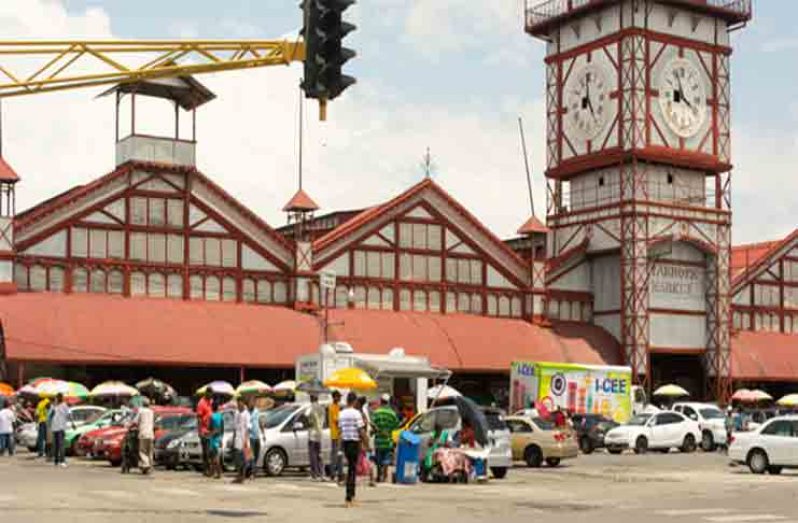FOR some time now, it has become an annual norm for independent taxi drivers around Georgetown to double, or even triple, fares during the Christmas season, and “short drops” around Georgetown which regularly cost $500 are currently going for $1000.
However consumers would have to wait quite a while to see this situation addressed, if ever, as it would seem there actually exists no regulatory laws, or authority that govern taxis or their fare structure, leaving all to the mercy of the drivers.
Both the Ministry of Business and Guyana Police Force (GPF) note that they do not have authority over the fare structures of taxis.
“I just think it’s really ridiculous,” expressed Murielle Bristol, who doled out a $1000 last week for a short drop.
“I literally came from the Ministry of Public Service on Waterloo Street to my office on Brickdam, and it was $1000. It’s a $500 drop but the guy was like ‘is Christmas after Christmas it gon’ go back down’. I was highly angered but because I’m a professional I couldn’t express myself how I wanted to so I just let it go, but it was really disappointing for me. They look me in my face and tell me the price is doubled, and you have to pay this money.”
Her sentiments were echoed by another person who shared that they were told that a taxi from Georgetown to Diamond on the East Bank would be a whopping $6000, a route where a taxi regularly costs $2500.
“It was a taxi outside Bounty [Supermarket] at Stabroek, I didn’t take him though. It’s ridiculous, highway robbery,” she conveyed.
Others who refuse to be exploited, are sticking to their primary mode of transportation, and walking their distances in resistance.
“I took a taxi from Georgetown to Pouderoyen [on the West Bank] and paid $2500. In Georgetown I needed one from upper Regent Street to down town and they needed $1000, likewise from Robb Street to Carmichael Street they wanted the same, so I walked regardless of my load,” Marcellus Grimmond shared of his encounter with the situation.
“They got more attitude than anybody else. No passenger does be happy about being exploited. They will always say something negative about that money or that driver and we know words have power, so they only doing themselves more harm than good. Nothing given insincerely will last.”
Justin Knights said he is also refusing to be abused.
“I had the money to pay the cost but I just refused to be exploited by taxi drivers. I don’t believe the taxi drivers are equipped with the necessary customer service to demand any increase. I flagged down several taxis on Regent Street between Orange Walk and Albert Street asking about the price to be transported to Durban Street and all of them said their price is $1000,” Knights notes.
Taxis attached to taxi companies are not allowed this practice, though some “base taxis” do try to at times with the hopes that they can get away with it.
The taxi drivers, however, explain that the fare is justified, given the traffic situation that obtains at this time of year, which sees short distances taking extended periods to traverse. “If passengers did not pay the fare I for one would not work during this time of year. Today I took 57 minutes from Demico Park [Stabroek] to GRA return. It cannot pay at the regular price, it won’t make sense,” explained taxi driver Kirk Jardine.
Public Relations Officer (PRO) at the Ministry of Business, Cordel McClure, relates that while that ministry has some amount of authority over minibuses and the control over their fare structure, it does not currently have monitoring responsibilities for taxis.
“There is no clear-cut indication as to who really has responsibility for monitoring the taxi fare. I don’t think that issue has ever been resolved. As far as I’m aware, I don’t think that there’s any entity that specifically has direct control over any fare structure for the taxis. The issue came up some time last year and based on what I recall what was said is that the ministry only really has responsibility for the minibuses,” he explained.
However, even in the case of the minibuses, fare regulation continues to be a challenge. Minibus operators continue to act as though they are a law unto themselves despite operating public transportation.
Many routes similarly increase their fares during certain peak hours, however this is not only relegated to the Christmas period and usually obtains throughout the year. For the Route 42, a passenger complains that the regular fare of $260 from Georgetown to Timehri is usually raised by minibus operators to $500 on ordinary days
“But during the Christmas time it gets worst, particularly Christmas Eve day. The police seem to be non-compliant where that is concerned and we are left to the mercy of unscrupulous drivers, drivers who don’t have a heart,” the passenger notes.
The situation of lack of fare regulation is not entirely regulated to the taxis around Georgetown, hire cars plying the Wales to Vreed-en-Hoop route on the West Bank of Demerara, on Monday, informed passengers as they entered their vehicles that an increase of fares from $160 to $200 for the two days prior to Christmas, was being instituted.
Regional Commander, Simon McBean, notes that, to the best of his knowledge, fare structure regulation does not come under the authority of the Guyana Police Force, so there is not much he thinks the police can do.



.jpg)








